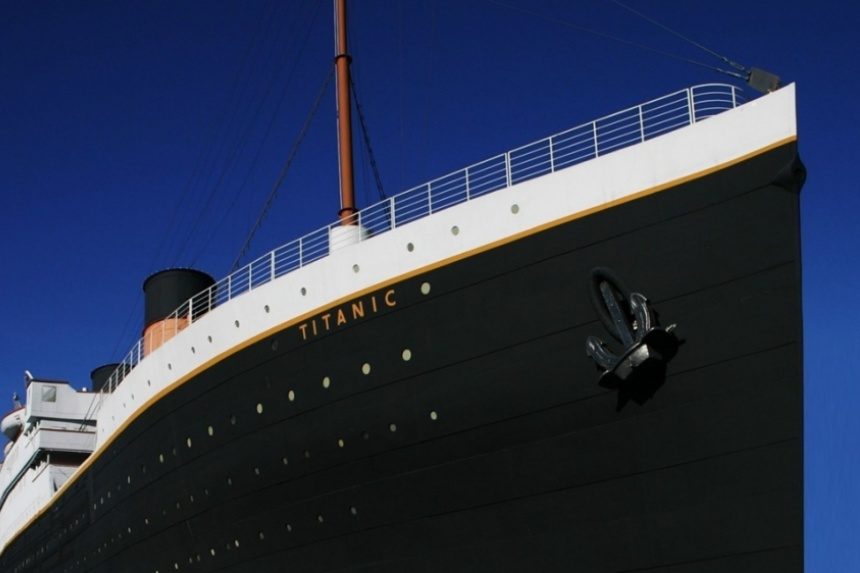When it comes to movies, people love disasters. Like the train derailment or the fiery car crash, we avidly consume the tragedy of the shipwreck in our pursuit of entertainment. Some of the highest grossing films in Hollywood history involve sinking ships. Here is a list of seven movies featuring sinking ships that are worth a watch this weekend.
1. The Poseidon Adventure
1973 was a great year for terrifying movies; the original Exorcist earned over $413 million, and The Poseidon Adventure was right on its tail. Although this disaster movie was released in 1972, The Poseidon Adventure became one of the highest grossing films of 1973, bringing in a worldwide gross over $125 million.
Based on Paul Gallico’s 1969 novel The Poseidon Adventure, the film is set of the SS Poseidon, a luxury liner making her last trip from New York to Athens before her retirement. Like any good disaster film, the movie opens with an introduction of each character and their reason for taking this life-changing trip. But The Poseidon Adventure doesn’t truly begin until an underwater earthquake sets off a tsunami that capsizes the ship on New Year’s Eve. The now upside-down SS Poseidon has transformed from a lush paradise to an unbearable hell. Its survivors, living in the air pockets formed during the ship’s descent, must find a way to escape their predicaments. A group of 10 people, led by Reverend Frank Scott (Gene Hackman), break off from the larger group, who wait like sitting ducks to be saved. The small group must work together to figure their way up and out of the boat, but will they survive or will their decision to leave end in their demise?
A massive tidal wave hits the SS Poseidon (Uploaded to YouTube by Movieclips)
The gripping movie, which has been compared to Airport (1970) and Earthquake (1974) – I would even throw Snakes on a Plane (2006) to this list — has won two Academy Awards, a British Academy Film Award, a Golden Globe Award, and a Motion Picture Sound Editors Award. Its sequel, Beyond the Poseidon Adventure (also based on Paul Gallico’s novel of the same name), was released in 1979. However, the sequel never hit the level of popularity achieved by the original Poseidon Adventure, only grossing $2.1 million.
2. Das Boot
Lothar-Günther Buchheim’s novel Das Boot, originally published in 1973, is based on his experiences serving on a German submarine during the Battle of the Atlantic (World War II). The novel was adapted into a film by the same name, and Das Boot was released in German cinemas in 1981. An English-dubbed version was released by Columbia Pictures, although it didn’t do as well in box office sales as its German counterpart. However, Das Boot, directly translating to “The Boat,” cumulatively grossed over $228 million in the U.S. and in international markets.
Like most war movies, Das Boot centers around tragedy. In the dangerous waters of the Atlantic during the Second World War, the German submarine U-96, the vessel on which the movie takes place, is on patrol. Most of the time the crew is bored and restless, until their excitement heightens when they spot enemy convoys. The crew is successful, and the vessel only sustains minor damages in many of these violent encounters. The men aboard U-96 find their luck is changed when they are suddenly attacked by a British fighter plane, the submarine suffering heavy damages in the bombardment. The U-96 is forced to dive, but when the boat fails to respond as the crew attempts to level her off, the men find themselves trapped underwater and running out of air. As they frantically work to repair U-96, the audience is left wondering: Will they make it to the surface in time? And, even then, can they sneak around their enemies and make it home?
3. Pearl Harbor
Michael Bay’s Pearl Harbor (2001) is one of the highest grossing war films in the world. Up there with Saving Private Ryan ($482.3 million) and Dunkirk ($527 million), Pearl Harbor grossed $449.2 million. The movie portrays the attack on USS Oklahoma and USS Arizona on December 7, 1941.
Opening in 1923 Tennessee, we are introduced to the film’s main characters, childhood best friends Danny Walker and Rafe McCawley, in their youth. But soon we find Danny and Rafe (and ourselves) launched 18 years into the future: January 1941. The young boys who played war together in an old biplane at the beginning of the movie are now men fighting in a real war, on real fighter planes.
As the Imperial Japanese Navy begins their attack on the U.S. Pacific Fleet, Danny and Rafe fight together against enemy planes and work to save the crews of the capsized Oklahoma and the swiftly sinking Arizona. Although both Danny and Rafe survive the attack, the war isn’t over (and neither is the movie). Can both friends continue to survive the raging world war? Or will their luck run out?
The attack on Pearl Harbor (Uploaded to YouTube by Movieclips)
Pearl Harbor is a dynamic film that explores themes such as love and hate, loyalty and betrayal during wartime. And with a cast of A-list actors, Ben Affleck, Cuba Gooding Jr., and Alec Baldwin (to name a few), it’s plain to see why the film was nominated for four Academy Awards, winning Best Sound Editing. Pearl Harbor wasn’t received with open arms by everyone. Outside of the Academy, the movie was also nominated for six Golden Raspberry Awards, including Worst Picture. It’s the first (and only) film in Hollywood history to be nominated for Worst Picture that had also won an Academy Award.
4. Jaws
Based on Peter Benchley’s 1974 novel and inspired by a real-life series of shark attacks on the New Jersey coastline in 1916, Jaws opens with a shark attack – it is night; two drunken young adults stumble towards the water for a late night skinny dip; the woman makes it to the water; the man does not; her half eaten body washes up on shore the next day; and the struggle between Amity Island and the Great White who terrorizes it begins. The killer lacks mercy, lacks bias, chowing down on men, women, and children alike. Yet, despite this ever-present threat and its determination to remain as a threat, the town refuses to close the beaches or warn vacationers of what lurks under the murky Atlantic waters.
Quint comes eye to eye with the shark (Uploaded to YouTube by Movieclips)
The only town official interested in protecting the beachgoers is Amity’s chief of police Martin Brody, who, along with marine biologist Matt Hooper and professional shark hunter Quint, sets of to defeat the shark and end its reign of terror. Out on the ocean, the small crew hunt the fish using spears, harpoons, and guns. Perhaps it’s the team’s lack of unity, or perhaps it’s the shark’s sheer strength and will, that places the ragamuffin crew on a sinking boat, both literally and metaphorically. As the vessel slowly descends, destroying the boundaries that separate man from fish, you find yourself seized by terror as you question whether or not Brody can kill the shark before he finds himself in the water, at its mercy.
Steven Spielberg’s Jaws was not an easy production. It ran into a variety of hurdles that put the film over budget and knocked it off its schedule. To begin, producers wanted to train a great white shark for the part of Jaws, but finding that to be a seemingly impossible task, the film employed three pneumatically powered prop sharks, nicknamed “Bruce,” as their bloodthirsty villain. Jaws was also the first movie to be filmed on the ocean, which presented troubleshooting issues and jacked the film’s budget up $5 million. But it was all worth it. Jaws grossed $470.1 million in box office sales, making it the highest grossing movie of 1975. The film was developed into three sequels and is preserved by the Library of Congress in the U.S. National Film Registry – along with Titanic, the only other movie on this list to be selected for preservation.
5. Titanic
Inspired by actual accounts of the sinking Titanic, which fell to the sea on April 14, 1912, the film was an ultimate success. And on March 1, 1998, Titanic became the first movie to gross over $1 billion in Hollywood history, hitting $2.202 billion in box office sales.
Opening 84 years after the tragedy, Titanic begins on a different boat: the Akademik Mstislav Keldysh, a research vessel exploring the Titanic wreck in search of a large diamond necklace called the Heart of the Ocean. Similar to Pearl Harbor, the audience is launched through time and space, except this time we are moving backward into the past.
Titanic movie trailer (uploaded to YouTube by YouTube Movies & Shows)
Now in Southampton in 1912, we follow 17-year-old Rose DeWitt Bukater (Kate Winslet), her mother, and her fiancé Caledon “Cal” Hockley as they board the RMS Titanic. On board, she meets Jack Dawson, a poor artist who won his voyage on the RMS Titanic in a poker game, and the two fall in love. Their love story is a classic, featuring all the best attributes of the genre: a scorned, vengeful lover; a domineering mother; class relations; and of course tragedy. The hardest part of watching Titanic, of watching this love story, is the suspense –knowing the tragedy will soon strike, but not knowing how it will affect their love. Will it overcome?
6. Frozen
While it may seem unlikely to see the Frozen franchise on this list, tragedy is not uncommon in Disney films, and this particular tragedy starts with a shipwreck.
A clip-compilation video from Disney’s Frozen (Uploaded to YouTube by Entertainment Access)
In the Frozen franchise, including Frozen ($1.26 billion) and Frozen II ($1.45 billion), which collectively garnered $2.71 billion in box office sales, Queen Elsa and Princess Anna, two royal sisters) share a similar origin story to that of other Disney protagonists: the tragic loss of one parent (usually the mother) or both parents. In Frozen, Anna and Elsa lose their parents to a shipwreck in the Dark Sea, a plot point that is introduced in the first movie and more fully fleshed out in the sequel. Their death places Elsa as ruler of the Kingdom of Arendelle, but pressures to hide her power over snow and cold from her citizenry send Elsa into an anxious frenzy that traps Arendelle in a seemingly endless snow fall. It is up to Anna and the friends she meets along the way to find Elsa and thaw the kingdom. But can Anna convince Elsa to return to the community that she once had to hide from?
7. Pirates of the Caribbean
Admittedly, only two of the six Pirates of the Caribbean films hit noteworthy financial milestones. In 2006, Pirates of the Caribbean: Dead Man’s Chest earned the title of the highest grossing film of the year at $1.06 billion in box office sales. And in two years in a row (2007 and 2008), the Pirates of the Caribbean franchise was the highest grossing film of the year with Pirates of the Caribbean: At World’s End at $963.4 million.
Beginning with the franchise’s Pirates of the Caribbean: Curse of the Black Pearl (2003), which is set in the 1720s, in Port Royal, Jamaica, the movie opens to a sinking ship and a young boy, Will Turner, who lies adrift in the water. Spotted by Elizabeth Swan, a young girl of the same age, he is pulled aboard a British ship transporting colonists to their new home in the Americas. Elizabeth spots a gold pirate medallion around Will’s neck, and thinking him a pirate (a crime punishable by death) and fearing for his life, she takes the medallion from his neck before he can be discovered. But she doesn’t realize its power.
Flashing forward eight years, we are introduced to Captain Jack Sparrow, a pirate captain without a ship. Like Will Turner, he makes his debut on a sinking ship. Well, a sinking sailboat that takes on water and slowly sinks as it nears the port. Only the crow’s nest remains above water. He is looking to commandeer ship belonging to the British Royal Navy so he can reclaim the Black Pearl from mutinous Barbosa and his cursed crew.
After Captain Sparrow’s introduction, the narrative shifts back to Elizabeth. With Will’s medallion around her neck, Elizabeth begins to feel very faint from her tight corset and the warm weather and falls into the ocean. Once that medallion makes contact with the water, it releases a siren call to the cursed crew of the Black Pearl, and this is where the adventure begins.
Pirates of the Caribbean: Curse of the Black Pearl official movie trailer (Uploaded to YouTube by YouTube Movies & Shows)
After Port Royal is raided and Elizabeth is kidnapped by the miscreant pirates, Will Turner and Captain Jack Sparrow team together in search of the Black Pearl. But will their competing goals – Will’s to save Elizabeth, Jack’s to retake his ship and defeat his sworn enemy – complicate their journey? This question persists throughout the franchise until Johnny Depp’s (Captain Jack) departure from Pirates of the Caribbean in 2018 – his last film being Pirates of the Caribbean: Dead Man Tell No Tales.
During his time with the franchise, Depp won a dozen awards for his performance as Jack Sparrow, along with award winning actors Orlando Bloom and Keira Knightley. Along with the phenomenal acting, this dynamic franchise featuring love and adventure as seen from the “dark” side (the pirate side) is a great family friendly movie geared for all ages, despite the sinking ships.
Featured image: Titanic movie poster (Roland Arhelger via the Creative Commons Attribution-Share Alike 4.0 International license, Wikimedia Commons).
Become a Saturday Evening Post member and enjoy unlimited access. Subscribe now



